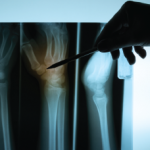Most Americans age 50 and older are at risk of a bone fracture caused by osteoporosis, which is why Medicare asks all new enrollees have their bone density measured. Dual-energy X-ray absorptiometry (DXA) is the gold standard to identify patients at high risk of bone fracture. DXA is also used to monitor the effectiveness of medical therapy to prevent and treat osteoporosis. However, declining reimbursement rates have made DXA increasingly difficult to provide, resulting in limited patient access to this preventive measure. At the current Medicare reimbursement rate—which has dropped 70% since 2006—it is not economically feasible for many doctors to maintain DXA equipment and administer these tests.
A study found increased DXA screening could have substantial benefits, preventing 3.7 million fractures and reducing total direct medical costs of osteoporosis by nearly $55 billion through 2040.1 To increase access to DXA testing, the bipartisan Increasing Access to Osteoporosis Testing for Medicare Beneficiaries Act (H.R. 3517/S. 1943) has been introduced in both the U.S. House and Senate to set a $98 floor for Medicare reimbursement for DXA testing. Join the ACR in asking your federal legislators to support this important bill.
For someone with osteoporosis, broken bone recovery can come with significant complications. Many patients have repeated fractures, some of which result in hospitalization, long-term care needs or worse. For example, one in three adults aged 50 and older dies within 12 months of a hip fracture and one in four ends up in a nursing home, which some patients fear more than death.2 These complications come at a staggering cost. In 2018, annual direct medical costs associated with osteoporotic fracture were estimated to be $48.8 billion and growing.1
A woman’s risk of having an osteoporotic fracture is greater than her combined risk of having a heart attack, having a stroke or developing breast cancer. In fact, one in two women—and up to one in four men—50 and older experience an osteoporosis-related bone break.3 More women die each year from complications following hip fractures than from breast cancer: 25% of women over the age of 50 who sustain a hip fracture die in the following year, 50% never walk independently again and 20% require permanent nursing home placement.4 By 2025, Medicare is projected to pay more than $25 billion each year for direct costs of new fractures.5
But osteoporosis is easily preventable with existing diagnostic tools and inexpensive treatments that reduce fractures. Medicare beneficiaries who receive a DXA bone density test have 35% fewer hip fractures and 22% fewer other fragility fractures. By setting a reimbursement floor for DXA, this legislation can drastically reduce the incidence of, and costs and disability associated with, osteoporotic fractures.
References
- Lewiecki EM, Ortendahl JD, Orgle-Vanderpuye J, et al. Healthcare policy changes in osteoporosis can improve outcomes and reduce costs. JBMR Plus. 2019 May 13;3(9):e10192.
- Katsoulis M, Benetou V, Karapetyan T, et al. Excess mortality after hip fracture in elderly persons from Europe and the USA: the CHANCES project. J Intern Med. 2017 Mar;281(3):300-310.
- National Osteoporosis Foundation. What women need to know. Accessed June 21, 2021.
- U.S. Department of Health & Human Services. Bone Health and Osteoporosis: A Report of the Surgeon General. December 2004.
- Blume SW and Curtis JR. Medical costs of osteoporosis in the elderly Medicare population. Osteoporos Int. 2011 Jun;22(6):1835-44.

